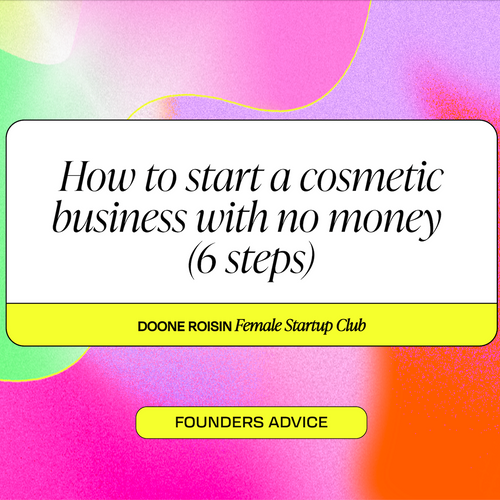
Convincing investors to spend money on your business can be a *very* daunting task. It has often been described as a full-time job all on its own. We won’t get into the statistics right now, but female entrepreneurs have a pretty tough run of it. To play the odds in your favor, it’s worth investing time in creating a super compelling pitch deck. The strength of your pitch deck is often the most apparent determinant of how well your money-raising journey will go. This is your chance to cement a great first impression. Your pitch deck must stand out among hundreds of others to secure a second meeting with investors. If you're keen to learn more about the elements of winning pitch decks, this is the article for you. Let’s get straight into it.
The crux of what you’re trying to achieve with your pitch deck is to tell a compelling story and leave a lasting impression within just a few minutes. Below we will explore the ten non-negotiable elements you should absolutely include in your pitch deck, tried and tested by many of the incredible female founders that we’ve had the honor to interview for Female Startup Club.
1. Problem and Solution
Let’s get back to the basics of business. One element that every winning investor pitch should have is a problem slide. It should precisely connect your audience to the existing market gap and its challenges. Bonus points for being realistic about the challenges of the market! This is the part where you people are excited about the vision of your business and why you’re the best possible person to run it. It all comes down to storytelling and marketing opportunities.
The problem slide is your opportunity to hook investors and compel them to believe your business needs to exist. This is your why. It should be concise but comprehensive to help them understand the following:
● The problem you'll be solving and why it is a problem
● Who is facing the consequences of the problem
● Why the problem cannot remain unresolved
Remember that you may not be the only entrepreneur who has identified the gap or the problem in the market. What will make you stand out among the competition is your unique value proposition (UVP) and exactly what differentiates you from the others. Investors will really want to hone in on your differentiated positioning, so many sure this part of the pitch deck is rock solid. An extra tip on the problem slide: investors won’t just want to hear about solving the problem but why you should be the one to solve it. This is your chance to get personal and really hone in on your “why” to start this business.
With every problem, we hope to see a solution. Your pitch deck should also contain a solution slide. The product or service you'll offer to bridge the market gap profitably. On a separate slide from the problem slide, give a precise and convincing narrative of your solution and why it stands out from the rest.
2. Purpose
Justin Bieber was onto something when he wrote “Purpose”. In entrepreneurship, we can see purpose as the north star guiding you in your business journey. Within your pitch deck, your purpose is best conveyed as a two to three-sentence summary of why your business exists and what it does. It focuses more on the business actions to service customer needs rather than values and shows how your product or services positively influence the target audience's lives.
Unlike a mission statement, which is actionable, the purpose statement is an ongoing pursuit that propels your business forward. It should show investors that your business is sustainable and scalable and that you’re the right person to be at the helm.
3. Traction
You can do all the best storytelling in the world, but at the end of the day, it’s your numbers that are going to tell the real story. The purpose of this traction slide is to demonstrate your track record of success using metrics (bc metrics don’t lie). A business that has been operating for a while will have an easier job of this, but there are plenty of alternative ways to support the metric piece as an early-stage founder. Focus on other available metrics relevant to your business to prove the marketing opportunity and convince the investors of your potential for growth and increased investment value into the future. Any “wow”-marketing moments, a glowing review, and a popping PR piece can be super effective here.
This part of the pitch deck is your first opportunity to get your creative hat on. The more compelling way of presenting traction is using visual aids like graphs and charts. Canva is your best friend here! To give you an idea of the more traditional metrics investors would be interested in seeing, consider: revenue, customer acquisition, sales volume, and team size.
4. Market Size
Logically, investors want to cash their money in opportunities with a large market or demand to get their investment value back sooner. There needs to be a real opportunity present in the market. However, most founders fail to articulate their market opportunities compellingly by discussing the Total Available Market (TAM) or Serviceable Available Market (SAM). Technical stuff, but both concepts are very well worth familiarising yourself with when building your pitch deck,
To convince investors about your market size, you should use a bottom-up approach to determine your minimum viable segment and roughly estimate the number of prospective buyers. With this understanding, you can predict your future growth and show investors exactly why your company is worth investing in.
5. Competition
nvestors are always concerned about this slide because they know every business faces indirect or direct competition. To reassure them you can withstand your rivals, you should present all your competitors' strengths and weaknesses in this slide. Guest on Female Startup Club and VC firm New Money Ventures’ founder Jaclyn Johnson recently spoke on the importance of bringing up the competition during your pitch and her comment really stuck with me. She said that “founders that don’t bring up competition and the edge over their competition are a real red flag - it’s important to be able to talk about the competitive landscape”. Keep that in mind when preparing the competition segment of your pitch deck.
You can use graphs to compare your product features to your competitors to prove your unique selling point and competitive advantage. You should also include the possible threats you anticipate from your competitors to show investors you're fully prepared to respond proactively to unfavorable outcomes.
6. Business Model
Next up, you’ll be digging into the specificities of your business model. The business model slide gives investors a solid reason to believe or not believe the feasibility of your business. It generally explains your business strategy or how your business will generate revenue.
Investors will be interested in having a clear idea of the following:
- Your revenue streams or the products you sell
- Your pricing strategy and the profit margin you generate per unit of your product
- How you'll distribute your products to customers to attain and maintain profitability
- How your pricing strategy compares to competitors
7. Financial Projection
When it comes down to it, investors are there for one reason and one reason alone. To make some bang for their buck. It’s important to highlight your financial projections moving into the future so investors can get a real insight into how their investments might turn out. Whilst they know financial projections may deviate from the actual values, they always want to know the assumptions you've made regarding your costs and growth in the next five years. It’s definitely worth taking this piece of the equation seriously. As the fantastic Tash Todd Williams from Word of Mouth Digital told us on the show: “know your numbers”. This is your opportunity to show that off.
The practice has shown us that investors are more concerned about your net income line than your cash position. In most cases, a projection of the income statement is enough. However, if you have a record of positive cashflows, you should absolutely present it to strengthen your pitch.
In a nutshell, this slide should disclose the following:
- Pro forma financial projections
- The assumptions or metrics that drive the financial model
- The operating income and profit margin
8. Roadmap
Investors love money. Money loves clarity. Those who you’ll be pitching will be interested to see where your business has come from, where is it now, and where it is going. This slide helps you paint the picture of your short and long-term actionable plan and truly take the investor on that journey with you. You can also get creative here with a timeline for achieving your goals, which really helps with building that accountability (but a small PSA here: make sure your roadmap strikes the balance between being concise and comprehensible - you want it to be packed with the most critical concepts).
For a few months now, we at Female Startup Club have been collating our guests' stories into 60 seconds TikTok videos, and they have proven to be immensely popular. If you’re looking for some inspo around sharing your story clearly and concisely, check out the stories we compiled for Erin Deering and Daniella Pierson. They’re a real vibe!
9. Team
Your business is as good as the team you choose to implement your strategies. Time and time again, we hear that the most critical decision you will make as a founder is who you decide to bring on board. The right team can really *make* a company. While your business idea is worth 30%, your team is worth 70%. And possibly even more, if you abide by the mantra we hear over again from guests on the show: always hire those smarter than you. Hire to fill in the gaps you cannot reach yourself, and that’s how you’ll build a great company.
Investors will be interested to know whether your team has the relevant background, skills, and experience to generate investment value. This is your opportunity to cheerlead the team you’ve built.
Introduce the investors to the following:
- The names, faces, and a brief overview of notable achievements of each team member
- Why have you chosen each member of your team
- The title or the role each team member plays and why they're best suited to do it
10. The Ask
Finally, after showing investors that your business has potential, it’s time to start asking what you came for. You will use this slide to show how *exactly* how much money you need and where and how you'll spend it. It really pays to be as concise as possible in these calculations, as it will promote just how considerate you will plan to be with the investors’ capital.
You should convince investors that:
- You know how much you need to achieve your business goals
- You know what to do with the money
- You'll start giving a return on investment after a defined period
Successful Pitch Deck Examples
If you’re anything like me, you’re probably itching to get your hands on some examples of successful pitch decks. Worry no more! Check out the following:
One of the best examples of a successful pitch deck is the Airbnb pitch deck. It helped the brand raise $600k in its seed stage. The outstanding quality of this pitch deck is its precision in showing the market need and using visual aids to create a first impression and to tell their brand story. Check out Airbnb’s pitch deck.
Another example of a successful pitch deck is the Facebook pitch deck. It helped Facebook secure a $500k seed fund. Although long, it includes relevant statistics and excellent descriptions of products that prove growth potential to investors.
Bad Pitch Deck Examples
Knowing what a successful pitch deck is can be just as helpful as knowing what an unsuccessful pitch deck looks like. Here’s what to avoid.
An example of a bad pitch deck is the MOZ pitch deck. Although this pitch deck includes all the necessary elements investors look for, it suffers from information overload. Most slides are crowded with visual aids and unnecessary information, making them difficult to follow.
Also, Foursquare's 1st Pitch Deck is a lousy example you should not emulate. They use small fonts and, as a result, exceed 100 words in some slides. Each pitch deck slide should have at most 50 words.
Best Software To Use for Creating Your Pitch Deck
Apart from having a viable business idea, a professionally crafted pitch deck can significantly increase your chances of success with investors. We all love a great visual experience. Fortunately, living in the 21st century has made things a bit easier on this front. You can use software to prepare your pitch deck without hiring a designer. It will help you present your concepts clearly and increase your chances of keeping the audience’s attention.
Prezi
Prezi offers flashy graphics and a canvas-based approach to help you break the monotony of linear slides. In Prezi, slides move around a large canvas. All you do is zoom in and out to present. It also has templates with different designs, fonts, and colors that you can edit to match your brand.
It has three subscription plans:
- Standard $7/mo
- Plus $12/mo
- Premium $16/mo
Adobe InDesign
Adobe InDesign is a powerful tool that can give your presentation slides a polished, precise, and organized look. It can add interactive features such as cross-references, charts, and graphs to make your pitch more compelling. For easy sharing, you can convert your slides into PDF or HTML5.
If you’re an entrepreneur with a creative side, InDesign is the best way to make your slides more aesthetic. The only downside is that it has a steep learning curve.
For individual use, the software requires a monthly subscription of $20.99.
Dropbox
Dropbox is more than a cloud storage option. It has simple navigation that can help beginners prepare presentation slides and slideshows. You can customize the templates and add data such as flowcharts, pie charts, and graphs. However, it might not be the best option if you're looking for sophisticated slide designs.
Though it has a free version, to access advanced features, you’ll have to choose one of the following monthly plans:
- Plus $9.99/mo
- Family $19.99/mo
Haiku Deck
Haiku Deck has over ten template themes, rich photo stock images, and restrictive designs that keep your pitch deck simple and elegant. Its interface is user-friendly, making it suitable even for beginners. It doesn’t have as many features as other platforms, but it’s an excellent choice for those who don’t know where to start.
Best Free Software for Pitch Decks
If you're on a budget and still want a unique design, you can look for free software for pitch decks.
Apple Keynote
Apple Keynote is only available for Apple users, but it offers intuitive pre-designed layouts and themes to enable you to prepare your slides quickly. It lacks some advanced tools available in PowerPoint, but it makes up for it in ease of use.
Canva
Our fave! Although Canva is famous for revolutionizing design, it also comes with all the tools for making top-notch presentation slides. It is beginner friendly because it has easily customizable templates with hundreds of fonts, grids, photos, charts, and graphs. You can access your slides online or download them in PowerPoint format.
Google Slides
Google Slides works better than PowerPoint presentations because it allows collaboration. Team players can access the slides online and make edits from anywhere. Its user interface encourages more straightforward presentations to give your deck a clean look. The downside is that it lacks professional design tools.
And lastly...
A big GOOD LUCK if you’re preparing to pitch to investors in the near future. If you’ve made it this far, I can promise you that you are well prepared, and you have got this! If you have found this article helpful in preparing your pitch deck, you might find some value in following us on Instagram. We regularly upload educational content and how-to’s for every stage of your journey, and our DMs are always open for a chat.



